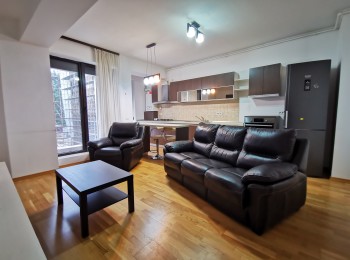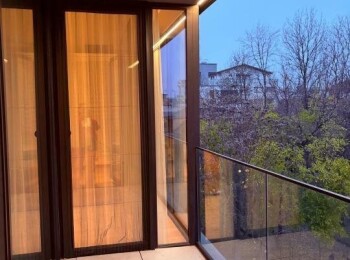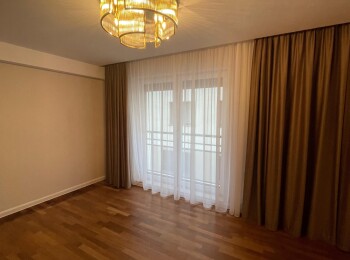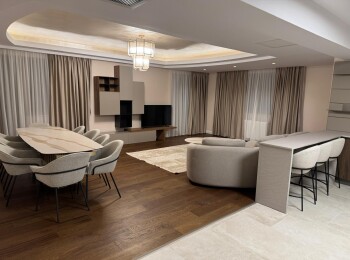Apartments for rent in Herastrau Nordului Bucharest Romania Sector 1 | BLISS Imobiliare Continue reading 37 listings Save
For rent apartments Herastrau Nordului Bucharest Romania Sector 1
37 listingsYou can also save properties to favorites by clicking on the heart icon.
 ID: 35558
- 8 December 2025
ID: 35558
- 8 December 2025
For rent 3 bedroom apartment
Herastrau, Bucharest
- In block
- 200 m²
- Renovated 2015
 ID: 142095
- 27 November 2025
ID: 142095
- 27 November 2025
For rent 3 bedroom apartment
Herastrau, Bucharest
- In block
- 205 m²
- Built 2008
 ID: 78851
- 9 January 2026
ID: 78851
- 9 January 2026
For rent 1 bedroom apartment
One Floreasca Lake I, Herastrau, Bucharest
- In block
- 61 m²
- Built 2013
 ID: 79047
- 8 January 2026
ID: 79047
- 8 January 2026
For rent 2 bedroom apartment
Aviatiei Nord, Bucharest
- Suitable for office
 ID: 122417
- 8 January 2026
ID: 122417
- 8 January 2026
For rent 2 bedroom apartment
Herastrau, Bucharest
- In block
- 103 m²
- Built 2004
 ID: 142033
- 5 January 2026
ID: 142033
- 5 January 2026
For rent 2 bedroom apartment
Habio Trifesti, Baneasa Aerogarii, Bucharest
- In block
- 80 m²
- Built 2024
 ID: 71925
- 5 January 2026
ID: 71925
- 5 January 2026
For rent 1 bedroom apartment
One Herastrau Plaza, Herastrau, Bucharest
- In block
- 70 m²
- Built 2018
 ID: 35391
- 30 December 2025
ID: 35391
- 30 December 2025
For rent 2 bedroom apartment
Herastrau, Bucharest
- In block
- 90 m²
- Built 2013
 ID: 117580
- 24 December 2025
ID: 117580
- 24 December 2025
For rent 3 bedroom apartment
Capital Residence Caramfil, Aviatiei, Bucharest
- In block
- 154 m²
- Built 2019
 ID: 4935
- 24 December 2025
ID: 4935
- 24 December 2025
For rent 1 bedroom apartment
Aviatiei Nord, Bucharest
- In block
- 57 m²
- Renovated 2020
 ID: 76954
- 23 December 2025
ID: 76954
- 23 December 2025
For rent 3 rooms apartment
Herastrau, Bucharest
- In block
- 113 m²
- Built 2000
 ID: 144430
- 18 December 2025
ID: 144430
- 18 December 2025
For rent 2 bedroom apartment
WIN Herastrau, Herastrau, Bucharest
- In block
- 102 m²
- Built 2020
 ID: 7923
- 17 December 2025
ID: 7923
- 17 December 2025
For rent 3 bedroom apartment
Herastrau, Bucharest
- In block
- 240 m²
- Built 2005
 ID: 141474
- 17 December 2025
ID: 141474
- 17 December 2025
For rent 2 bedroom apartment
One Herastrau Park, Herastrau, Bucharest
- In block
- 90 m²
- Built 2017
 ID: 126613
- 16 December 2025
ID: 126613
- 16 December 2025
For rent 1 bedroom apartment
North Area Lake View, Aviatiei Sud, Bucharest
- In block
- 60 m²
- Built 2011
 ID: 88765
- 14 December 2025
ID: 88765
- 14 December 2025
For rent 2 bedroom duplex apartment
Primaverii, Bucharest
- In block
- 240 m²
- Built 2012
 ID: 143477
- 13 December 2025
ID: 143477
- 13 December 2025
For rent 1 bedroom apartment
Baneasa Aerogarii, Bucharest
- In block
- 60 m²
- Built 2014
 ID: 119009
- 12 December 2025
ID: 119009
- 12 December 2025
For rent 1 bedroom apartment
Herastrau, Bucharest
- In block
- 80 m²
- Built 2009
 ID: 142880
- 12 December 2025
ID: 142880
- 12 December 2025
For rent 3 bedroom apartment
Charles de Gaulle, Bucharest
- In block
- 155 m²
- Built 1998
 ID: 120714
- 12 December 2025
ID: 120714
- 12 December 2025
For rent 3 bedroom apartment
Lighthouse Residence, Herastrau, Bucharest
- In block
- 116 m²
- Built 2018
 ID: 143749
- 10 December 2025
ID: 143749
- 10 December 2025
For rent 2 bedroom apartment
WIN Herastrau, Herastrau, Bucharest
- In block
- 78 m²
- Built 2020
 ID: 101576
- 10 December 2025
ID: 101576
- 10 December 2025
For rent 2 bedroom apartment
Persepolis Palladian Condominium, Herastrau, Bucharest
- In block
- 145 m²
- Built 2008
 ID: 31113
- 10 December 2025
ID: 31113
- 10 December 2025
For rent 3 bedroom apartment
Jean Monnet Residence, Primaverii, Bucharest
- In block
- 210 m²
- Built 2014
 ID: 143270
- 9 December 2025
ID: 143270
- 9 December 2025
For rent 2 bedroom apartment
Herastrau, Bucharest
- In block
- 109 m²
- Built 2017
 ID: 143754
- 9 December 2025
ID: 143754
- 9 December 2025
For rent 2 bedroom apartment
Nordului, Bucharest
- In block
- 91 m²
- Built 2009
 ID: 143755
- 9 December 2025
ID: 143755
- 9 December 2025
For rent 2 bedroom apartment
Nordului, Bucharest
- In block
- 150 m²
- Built 2009
 ID: 123945
- 9 December 2025
ID: 123945
- 9 December 2025
For rent 2 bedroom apartment
Herastrau, Bucharest
- In block
- 100 m²
- Built 2010
 ID: 100508
- 9 December 2025
ID: 100508
- 9 December 2025
For rent 1 bedroom apartment
Baneasa Aerogarii, Bucharest
- In block
- 70 m²
- Renovated 2025
 ID: 119645
- 8 December 2025
ID: 119645
- 8 December 2025
For rent 2 bedroom apartment
Nordului, Bucharest
- In block
- 156 m²
- Built 2010
 ID: 143402
- 8 December 2025
ID: 143402
- 8 December 2025
For rent 3 bedroom penthouse apartment
Herastrau, Bucharest
- In block
- 335 m²
- Built 2012
Close to the metro Aviatorilor and Aurel Vlaicu on the M2 line

Green and popular area with recreational park and lake North Bucharest
When you wish to have a reliable partner who assists you during the rental process and you consider to work with a professional real estate agency you can call us at +40 729 005 624 or send us a message.
You may also list your property HERE . Listing your property is free and you will benefit, as many others already do, of the BLISS Imobiliare reach in the market.
Living in the Herastrau Bucharest area (Also known as the French village) is very popular with expats and Romanians that wish to live in a high end luxury lifestyle. This area is defined as the area between Soseaua Nordului, facing the park, and Strada Nicolae Caramfil on the East side. Also the areas directly around the park like Aviatie, Aviatorilor, Primaverii, Dorobanti, Kiseleff, Domenii and Floreasca are by many considered as Herastrau vicinity areas.
Walking to the park from these areas will take you about 10-15 minutes. The closest metro stations are Aurel Vlaicu (10-15 minutes walk) and Aviatorilor which is at the Piata Charles de Gaulle entrance of the park. (Also about 10-15 minutes walk from the Nordului area) Buses are available at different stops on Strada Nicolae Caramfil taking you to the center of Bucharest or the Baneasa shopping mall.
The majority of residential properties for rent are in apartment blocks which have been built after 2000 of which the majority in the 2004-2012 period!
Especially the first line buildings facing the Herastrau park on Soseaua Nordului are very popular, but they are also the most expensive. The buildings built between the first line and the Strada Nicolae Caramfil have been built very densely with little concern for infrastructure access and privacy. The apartments here are less expensive than the first line and have been built mostly in the 2010 to 2018 period. There are still many constructions going on in very dense and less private manner. The first apartments built are mostly large size apartments of more than 200m2 while nowadays more and more apartments of 60 to 150m2 are built.
Rents in this area will be between 600 euro up to 10.000 euros depending on the type, position, quality and what amenities are offered.
Herăstrău Park (Wikipedia)
Herăstrău Park (Romanian: Parcul Herăstrău) or King Michael I Park is a large park on the northern side of Bucharest, Romania, around Lake Herăstrău, one of the lakes formed by the Colentina River.
Geography
The park has an area of about 187 ha, of which 74 ha is the lake. Initially, the area was full of marshes, but these were drained between 1930 and 1935, and the park was opened in 1936. The park is divided into two zones: a rustic or natural zone (the Village Museum), which is left more or less undisturbed, and a public 'active' domain with open areas for recreation activities. Small boats are allowed on the lake.
Name
The park was initially intended to be called Parcul Național, but it was renamed Parcul Carol II during the period of the Carol II of Romania's personality cult. Following World War II, it was renamed Parcul I. V. Stalin, featuring a statue of Stalin at its entrance. The park was renamed and the statue was torn down in 1956 as part of the De-Stalinization in Romania.
The name Herăstrău refers to the Herăstrău lake, and has its origin in a dialectal version of the word ferăstrău in standard Romanian, meaning saw or sawmill, referring to the water-powered sawmills that were once found the Colentina river which flowed through it. The current name for the park is King Michael I Park, which was renamed in December 2017 by the Bucharest General Council.
History
The area of the park has been inhabited since the Paleolithic, traces of settlements being found at the Herăstrău sand quarry, including flint tools made by the Mousterian culture, a culture generally associated with the Neanderthals. During the quaternary glaciation, the area was inhabited by large mammals such as the woolly rhinoceros and the mammoth, bones of the latter being found in the Herăstrău sand quarry.
During the iron age, a settlement of the first part of the Hallstatt era belonging to a pastoral population was located in Bordei-Herăstrău (the area between Herăstrău and Floreasca lakes, today part of the Herăstrău Park, which gives the name of the culture (Bordei-Herăstrău culture). In the Dacian settlements of Herăstrău, which has been dated, with the help of the coins, to the 1st century BC, archeologists found a treasure containing silver fibulae, silver spiral bracelets, a silver bowl, as well as Ancient Greek coins (from Tomis and Dyrrachium) along with Dacian imitations.
Phanariote Prince of Wallachia Alexander Ypsilantis built an Ottoman-style kiosk (summer house) on the banks of the Herăstrău Lake. The plain along the lake was used in 1831, during the Russian occupation, for military exercises by a joint force of the Wallachian and Russian militaries. By the mid-19th century, Herăstrău was the main promenade area used by the Romanian élite for walks.
In 1936, the work began for the creation of the National Park (Parcul Național) in Herăstrău. For this, several dozen squalid houses, as well as an industrial plant were expropriated and torn down, being replaced with alleys and trees, being finally open for the public in May 1939, becoming Bucharest's largest park.
Buildings and facilities
Elisabeta Palace, the current residence of the Romanian Royal Family, is located in the park, as an "island" inside the Village Museum, near the Arch of Triumph ("Arcul de Triumf").
A number of buildings are found within the Herăstrău Park. The most notable is the Dimitrie Gusti National Village Museum in Bucharest, an open-air museum showcasing traditional life of the Romanian peasant and having hundreds of houses from across Romania.
Scattered across the park are an open-air theatre, a yacht club, a sports club, the Herăstrău Hotel and, adjunct to the park, the Diplomatic Club, featuring a golf course.